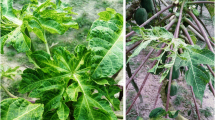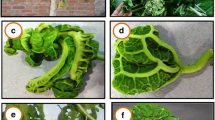Abstract
Transgenic Carica papaya plants (cv. Sunset, R0 clone 55-1) carrying the coat protein gene of papaya ringspot virus (strain HA 5-1) remained symptomless and ELISA-negative for 24 months after inoculation with Hawaiian strains of papaya ringspot virus under field conditions. Non-transgenic and transgenic control plants lacking the coat protein gene developed disease symptoms within one month after manual inoculation or within four months when natural aphid populations were the inoculum vectors. Mean trunk diameter was significantly greater in cloned 55-1 plants compared with virus-infected controls (14.7 cm versus 9.3 cm after 18 months). Fruit brix, plant morphology, and fertility of 55-1 plants were all normal, and no pleiotropic effects of the coat protein gene were observed. These results indicate that pathogen-derived resistance can provide effective protection against a viral disease over a significant portion of the crop cycle of a perennial species.
Similar content being viewed by others
References
Clark MF, Adams AN: Characteristics of the microplate method of enzyme-linked immunosorbent assay for the detection of plant viruses. J Gen Virol v34: 475–483 (1977).
Conover RA: Evaluation of methods for detection of tolerance to distortion ringspot virus in papaya. Am Soc Hort Sci Trop Reg 20: 51–57 (1976).
Conover RA, Litz RE: Progress in breeding papayas with tolerance to papaya ringspot virus. Proc FL State Hort Soc 91: 182–184 (1978).
Fitch MMM: Development of genetic transformation systems for papaya. Doctoral dissertation, University of Hawaii, Honolulu (1991).
Fitch MMM, Manshardt RM, Gonsalves D, Slightom JL, Sanford JC: Stable transformation of papaya via microprojectile bombardment. Plant Cell Rep 9: 189–194 (1990).
Fitch MMM, Manshardt RM, Gonsalves D, Slightom JL, Sanford JC: Virus resistant papaya plants derived from tissues bombarded with the coat protein gene of papaya ringspot virus. Bio/technology 10: 1466–1472 (1992).
Fitchen JH, Beachy RN: Genetically engineered protection against viruses in transgenic plants. Annu Rev Microbiol 47: 739–763 (1993).
Grumet R: Development of virus resistant plants via genetic engineering. Plant Breed Rev 12: 47–79 (1994).
Ishii M, Holtzmann OV: Papaya mosaic disease in Hawaii. Plant Dis Rep 47: 947–951 (1963).
Jefferson RA: Assaying chimeric genes in plants: the GUS gene fusion system. Plant Mol Biol Rep 5: 387–405 (1987).
Murphy FA, Fauquet CM, Bishop DHL, Ghabrial SA, Jarvis AW, Martelli GP, Mayo MA, Summers MD (eds) Virus Taxonomy, pp. 350–354. Springer-Verlag, Vienna (1995).
Powell Abel P, Nelson RS, De B, Hoffman N, Rogers SG, Fraley RT, Beachy RN: Delay of disease development in transgenic plants that express the tobacco mosaic virus coat protein gene. Science 232: 738–743 (1986).
Purcifull D, Edwardson J, Hiebert E, Gonsalves D: Papaya ringspot virus. CMI/AAB Descriptions of Plant Viruses No. 292 (1984).
Quemada H, L' Hostis B, Gonsalves D, Reardon IM, Heinrikson R, Heibert EL, Siew LC, Slightom JL: The nucleotide sequences of the 3′-terminal regions of papaya ringspot virus strains W and P. J Gen Virol 71: 203–210 (1990).
Sanford JC, Johnston SA: The concept of parasite-derived resistance: deriving resistance genes from the parasite's own genome. J Theor Biol 113: 395–405 (1985).
Tennant P, Gonsalves C, Ling K, Fitch MMM, Manshardt RM, Slightom JL, Gonsalves D: Transgenic papaya expressing the coat protein gene of a Hawaiian isolate of papaya ringspot virus and a classically cross-protected papaya show limited protection against isolates from different geographical regions. Phytopathology 84: 1359–1366 (1994).
Yeh S-D, Jan F-J, Chiang C-H, Doong T-J, Chen M-C, Chung P-H, Bau H-J: Complete nucleotide sequence and genetic organization of papaya ringspot virus RNA. J Gen Virol 73: 2531–2541 (1992).
Yeh S-D, Gonsalves D: Practices and perspective of control of papaya ringspot virus by cross protection. Adv Dis Vector Res 10: 237–257 (1994).
Zee FT-P: Breeding for papaya ringspot virus tolerance in solo papaya, Carica papaya L. Doctoral dissertation, University of Hawaii, Honolulu (1985).
Author information
Authors and Affiliations
Rights and permissions
About this article
Cite this article
Lius, S., Manshardt, R.M., Fitch, M.M.M. et al. Pathogen-derived resistance provides papaya with effective protection against papaya ringspot virus. Molecular Breeding 3, 161–168 (1997). https://doi.org/10.1023/A:1009614508659
Issue Date:
DOI: https://doi.org/10.1023/A:1009614508659




